Description
Introduction to Pipeline Pigging
Oil and gas pipelines are prone to corrosion during long-term transportation. Therefore, it is very important to clean the pipes regularly. What can be used to clean the pipes? The answer is pipe pigging. As a Chinese manufacturer, we offer a wide range of pipe cleaners. By the way, the process of cleaning with a cleaning pig is called a pig.
In the long-term operation of oil and gas pipelines, corrosion is an inevitable challenge, and the regular cleaning of pipelines is a crucial task. An effective solution is to use a pig. As a reputable manufacturer in China, we offer a variety of pipe cleaners that are an integral part of the pipe cleaning process and are commonly referred to as pipe cleaners.
The Necessity and Mechanics of Pigging in Pipeline Maintenance
With the extension of the service life of natural gas pipelines, pigging has become an essential maintenance operation. The technology provides a clear understanding of the internal condition of the pipeline. If any defect is found in the pipeline, it can be repaired and maintained in a timely manner, thereby reducing the cost of the pipeline.
The Role of Pigging in Ensuring Pipeline Safety and Efficiency
Today’s pigging technology can accurately collect relevant data and information, allowing us to conduct a baseline assessment of the gas pipeline. This information can be used as a reference for comprehensive evaluation, helping to improve the overall level of protection of natural gas pipelines and ensure their long-term safe operation.
In addition, the process helps avoid gas leakage due to pipe corrosion and perforation. We place particular emphasis on the type of pig used in the pipeline. The selection of pigging measures in pipeline pigging technology and the key issues involved in long-distance pipeline pigging technology are our main concerns. These insights have made important contributions to the pigging technology of long-haul natural gas pipelines.
Importance of Pipeline Pigging Pigs
Regular cleaning of pipelines with pipe cleaners is very important to maintain the efficiency of long-distance natural gas pipelines. Specifically, due to the accumulation of hydrogen sulfide corrosion products caused by prolonged use, frequent cleaning is required.
In order to ensure the normal operation and efficiency of gas transmission pipeline, timely and effective pigging work is very important. In addition to hydrogen sulfide corrosion products, condensed water and debris can build up in pipes, creating a risk of clogging and equipment failure. Regular pigging of the pipe can help avoid these problems.
In order to ensure the stability and safety of the pigging operation, it is very important to ensure the recovery of the pigging device after deployment. This often requires adapting the pipeline flow in the working area to the actual application of the network, while minimizing disruption to users. It is also important to control the speed of the pig. Therefore, it is very important to analyze and discuss the pigging technology of natural gas long distance pipeline.
Types of Pipeline Pigging Pigs
Foam Pigs
The foam pig consists of lightweight, flexible polyurethane foam. They are versatile and can be used for a variety of operations, including drying, cleaning and displacement of liquids in pipes. Their flexibility allows them to traverse bends and fittings and adapt to changes in pipe diameter. Foam pigs are usually coated with polyurethane elastomers to improve their durability and wear resistance.
Skeleton Pigs
A skeleton pig, also known as a mandrel pig, consists of a steel frame or “skeleton” to which various components, such as brushes, plates or cups, can be attached, depending on the specific pipe cleaning task. This modular design makes the skeleton pig highly versatile and customizable for a variety of pipeline conditions. They are often used for more intensive cleaning tasks, including removing scale, rust or other solid debris from pipes.
Solid-Cast Pigs
Solid cast pigs are made from a piece of polyurethane, making them very durable and strong. They are ideal for heavy duty applications including pipe cleaning, cleaning and displacement tasks. Solid cast pig is available in a variety of designs and hardness levels to meet different pipe configurations and pigging goals. Its robust construction ensures a high degree of sealing, making it ideal for isolating different fluids in pipes.
Methods for Applying Pigging for Long-distance Natural Gas Pipelines
(1) Pigging Strategy for Waxy Crude Oil Pipelines
Waxy crude oil pipeline will accumulate oil wax deposits on the wall after a period of use. Once these deposits reach a certain thickness, pigging operations are necessary. This initiative not only reduces operating costs, but also increases the capacity of the gas pipeline. Suitable soft pig and mechanical pig equipped with tracker must be selected for wax and pipe cleaning.
The pigging operation begins with the use of a soft foam pig to collect detailed information about the condition inside the pipe. Once the pipeline is cleared, mechanical pig will be deployed. Equipped to handle impurities and foreign objects, the mechanical pig is fully cleaned using its steel brush. This can completely remove the wax deposits and corrosion rust on the pipe walls.
Essentially, the pigging process is a two-step process: first a preliminary investigation with a soft pig, followed by a thorough cleaning with a mechanical pig. This method ensures safe, efficient maintenance and long-term use of waxy crude oil pipelines.
(2) Pigging Techniques for Gas Pipeline Applications
Natural gas pipelines typically carry gases including carbon dioxide and hydrogen sulfide, which can combine with water to form hydrates that cause clogging. This situation not only obstructs the flow of natural gas pipelines and equipment, but also has safety risks. In order to prepare such a gas pipeline for operation, we usually choose a traditional pig for the pigging task.
For example, a leather bowl pig is particularly effective for natural gas lines that carry moisture. Their main function is to remove water from pipes. In this case, we used the straight plate pig, which is known for its superior sealing performance, to carry out the cleaning process.
In cases where a natural gas pipeline originates in a basement or gas field, the pipeline may contain condensate, such as light hydrocarbons. Here, the straight plate pig is used directly in the removal process.
(3) Pigging Strategy for Natural Gas Pipelines: Transporting Mixed Oil and Water
During the long-term use of natural gas pipelines, especially those dealing with two-phase flow for a long time, liquid accumulation and inner wall corrosion may occur. These liquids usually accumulate in the lower parts of the pipe, resulting in increased pressure drop and reduced flow area in the pipe.
The factors that affect the pigging efficiency of a two-phase flow pipeline are:
The allowable flow rate and pressure drop of the gas-liquid mixture in the pipeline
The gas-liquid ratio in the pipeline
Pipeline profile
The volume of liquid that accumulates in a pipe
The size of the pig trap
The height difference between the bottom of the riser and the pig in an offshore pipeline system
Standard pigging procedures for two-phase flow pipelines usually use traditional pigging balls and piggers. In addition, pig with bypass system can also be used for pigging.









Reviews
There are no reviews yet.